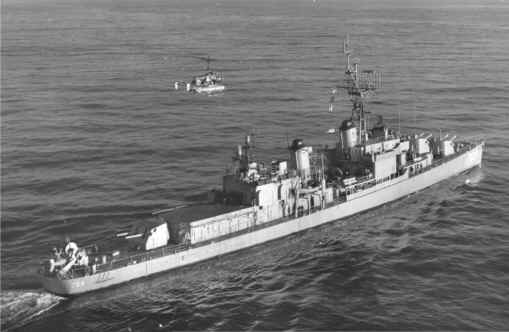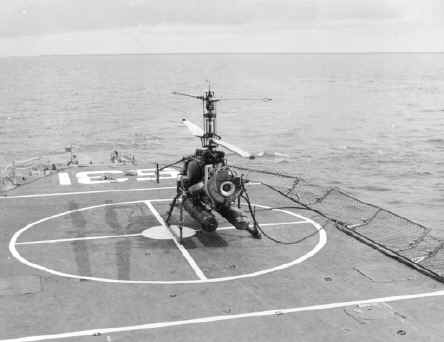
|
|
|
The Advantages of the Gyrodyne Contra-Rotating Coaxial Rotor Helicopter Configuration.
When Gyrodyne won the pilot-less helicopter ASW (anti-submarine warfare) program, competing against Kaman Helicopters, on December 31, 1958, it did so not just because Gyrodyne's coaxial rotor system demonstrated a higher payload capacity but also because of the many other benefits a coaxial rotor system provided for, given the need for a small sized airframe to operate from small destroyer-sized flight decks, which it did from 1963 to 1970 as the Drone Anti-Submarine Helicopter (DASH). Below are just a few of the benefits the U.S. Navy realized using the Gyrodyne Coaxial Rotor system for their 1960's version of the VTUAV (Vertical Takeoff or Landing, Tactical Unmanned Aerial Vehicle). Ultimate Compactness : The Gyrodyne Coaxial presents the ultimate in compactness for small ship decks as the fuselage is entirely functional (carries no rotor torque reactions) with no need to provide either a long boom for a tail rotor, or an overly long fuselage for the purpose of rotor separation. The components of the control system are short thereby improving control responses and effectiveness and the configuration presents the least vulnerable area of critical components. Accordingly, the wetted area of the Coaxial on the same payload basis is much smaller than either the tail rotor or the tandem configurations, thus allowing for multi-coaxial vehicle storage in small hangar decks and therefore increasing shipboard multi-mission capabilities and utilization.High Useful Load : The absence of a tail rotor from the Gyrodyne Coaxial permits all of the engine power to be used by the rotor system for lifting purposes. Therefore, in comparison with a tail rotor configuration, the useful load of the Gyrodyne Coaxial is higher. What about Multi-rotor configurations? The substantially lower weight and the lower transmission and shaft power losses of the Coaxial as compared to the tandem configuration gives the Coaxial a useful load advantage over the tandem or any other multi-rotor configuration.Safe Deck and Ground Characteristics : In cross winds on a rolling pitching and heaving ship’s deck, or on the ground, the following make the handling of the Gyrodyne Coaxial much simpler
than any other type: (1) The inherent torque neutralization characteristics of
the Coaxial Rotor System eliminates dangerous inertia and torque effects, ground
looping and cross wind effects during quick starts and stops of the rotor
system; (2) The use of the semi-rigid rotor system assures freedom from ground
resonance; and finally, (3) the automatic gust locks in the Coaxial Rotor System
prevent blade flapping at low the following make the handling of the Gyrodyne Coaxial much simpler
than any other type: (1) The inherent torque neutralization characteristics of
the Coaxial Rotor System eliminates dangerous inertia and torque effects, ground
looping and cross wind effects during quick starts and stops of the rotor
system; (2) The use of the semi-rigid rotor system assures freedom from ground
resonance; and finally, (3) the automatic gust locks in the Coaxial Rotor System
prevent blade flapping at low
Low Empty Weight: The feature that makes the fuselage independent of the lifting system dynamics permits the design of the fuselage to be strictly functional as related to mission requirements. Accordingly, the size of the coaxial rotor system fuselage for the same useful load is smaller than any other type and structurally
simpler, resulting in lower fuselage weight. Consider these other weight
savings: same useful load is smaller than any other type and structurally
simpler, resulting in lower fuselage weight. Consider these other weight
savings:
(1) The weight of the Coaxial transmission system for a given horsepower is lighter than the total weight of the two or more transmissions systems utilized in either the anti-torque tail rotor or tandem rotor configurations. (2) The total blade area of the Coaxial Rotor is essentially equal to the blade areas of the main rotor of a comparable single rotor and it is slightly higher as compared to other multi-rotor systems. (3) The total weight of the fuselage, transmission, and rotor system of the Coaxial Rotor Helicopter is found to be slightly lower than that of an equivalent engine horsepower of a tail rotor configuration and substantially lower than that of the tandem or other multi-rotor configurations. Complete Symmetry of the Rotor System : The symmetry of the Coaxial Rotor System permits the same aerodynamic efficiency and controllability for flight in any direction; a feature only found in the coaxial.Simplified Rotor System The Gyrodyne Coaxial utilizes the semi-rigid type of rotor system without the need for use of mechanical stabilizing devices, thus resulting in a simpler rotor system design possessing excellent flying qualities. The simplicity of design yields benefits such as lower structural weight, manufacturing and maintenance costs. In addition, this rotor system makes the helicopter free from ground resonance. The size of the rotor diameter in the Gyrodyne Coaxial is totally independent of the fuselage. This feature, of disassociating the rotor diameter size from the fuselage, becomes considerably important in heavy lift helicopters. Freedom from Control Cross-Coupling : Control cross-coupling exists in all other rotor configurations, causing control complexity, dangerous flight attitudes and vibration. Lack of control cross-coupling in the Gyrodyne Coaxial Helicopter yields the following advantages:
Low Tooling and Manufacturing Costs: On a dollar-per-pound basis the Coaxial has an advantage over the other configurations because of of its lower empty weight; this advantage is further amplified by the following two features:
Modular Construction:
The closed-loop torque-balanced Coaxial Rotor System eliminates torque
reactions on the fuselage, thus making the fuselage a totally independent body
from the rotor-transmission-engine combination. In the Gyrodyne Coaxial, all four controls (longitudinal and lateral cyclic, collective and directional control) are independent of each other and completely incorporated in the lifting rotor system. This feature makes it possible to consider the engine, transmission, rotor and its controls as a major subassembly, referred to hereinafter as the Propulsion-Power Plant Package. The independence of the Propulsion-Power Plant Package from the fuselage yields several advantages, the primary ones being:
To further emphasize the independence of the Propulsion-Power Plant Package from the fuselage, the following examples are presented. Once the design of a Propulsion-Power Plant Package has been developed, a number of functional fuselages can be designed and adapted to it without causing a need for redesign of the Package. Within limits, the opposite is true. A fuselage can be utilized with somewhat different Propulsion-Power Plant Package without calling for redesign of the functional fuselage. The economics of this feature cannot be over-emphasized, especially during a period when requirements are constantly changing (also known as requirement creep). Growth Potential: The many growth areas that a Coaxial helicopter permits are as follows:
|
|
The name "Gyrodyne" in its stylized
form above, is the Trademark of and owned by the Gyrodyne Helicopter Historical
Foundation; unauthorized use is PROHIBITED by Federal Law. All Photographs, technical specifications, and
content are herein copyrighted and owned exclusively by Gyrodyne Helicopter
Historical Foundation, unless otherwise stated. All Rights Reserved
©2013. |